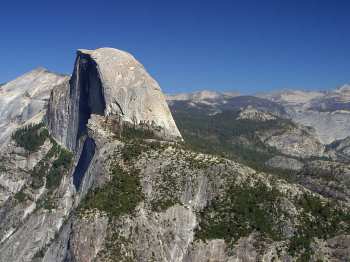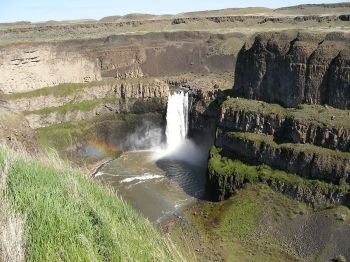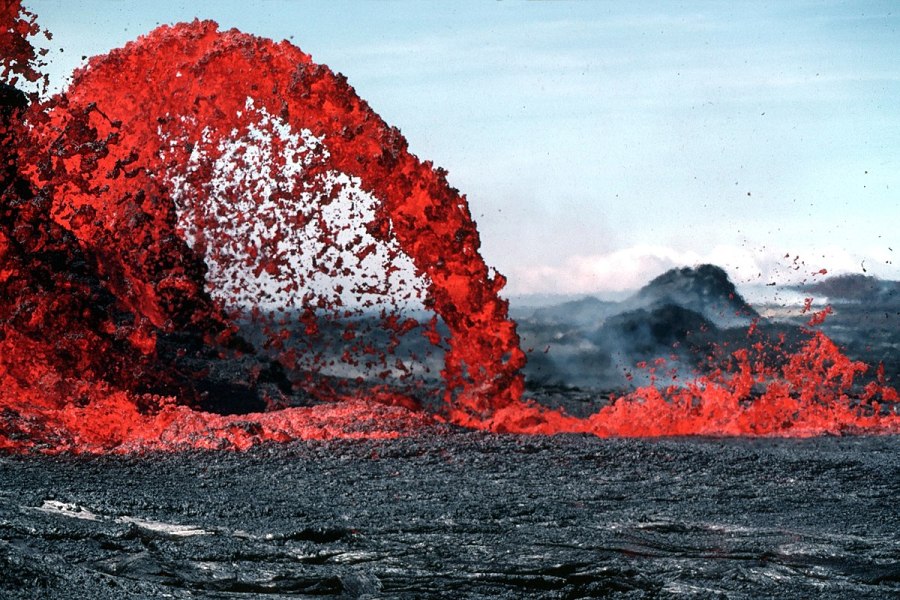This is the first in a planned six-part series of Six Geological Reasons Why I am Not a Young-Earth Creationist. I am a Christian who holds to the inerrancy and authority of the Bible, and who also has a master’s degree in geology. I have previously given my biblical and theological reasons why I believe the Bible does not require a young Earth. This present series will have six parts:
Each of these broad geological arguments against young-Earth creationism can be summarized as: Too many events, too little time. |
Introduction
Since the 1700s, most scientists, Christian or otherwise, who have studied the Earth have concluded that there is overwhelming evidence that Earth is many millions of years old. The evidence for an ancient Earth has come from many subdisciplines of geology, including the study of igneous, sedimentary, and metamorphic rocks; fossils, and surficial layers formed by processes such as glaciation. Radioactivity was not discovered until well after widespread acceptance that Earth is many millions of years old, and radiometric dating has confirmed what other evidence already pointed to.
Modern young-Earth creationists (YECs), on the other hand, claim that geological evidence can be re-interpreted to allow for—or even require—a young Earth. Often these YEC understandings of Earth history focus on single events that can happen relatively quickly, such as the deposition of a single layer of sediment or crystallization of a single lava flow. They say that if certain individual geological events can happen quickly, then it didn’t have to take millions of years to form the entire geologic column. Often YECs ignore the context of these single events and underestimate the complexity and necessary timelines of all the features that surround that individual rock unit. The truth of the matter is that Earth’s crust presents a record that has too many events to fit the abbreviated YEC time scale, which posits that most features in Earth’s crust formed in the short one-year timeframe of Noah’s flood.
From my perspective as a Christian who accepts the truthfulness and authority of the Bible, scriptural arguments allowing for an old Earth are of utmost importance. I was once a YEC myself and did not switch to being an old-Earth Christian until I became convinced that the Bible does not require us to believe in a young Earth or a global flood. As you read this article, please remember that the Bible does not tell us how igneous rock bodies came to exist in Earth’s crust. YECs insist that most of these rocks were formed during Noah’s flood, but that is merely an unjustifiable extrapolation from Scripture rather than being something that the Bible itself teaches.
Intrusive (Plutonic) Igneous Rocks

Igneous rocks are formed by the cooling and crystallization of molten rock. Intrusive igneous rocks are those that crystallize underground, sometimes at great depth beneath Earth’s surface. Extrusive igneous rocks, on the other hand, are those that crystallize on Earth’s surface by volcanic processes. Molten rock on Earth’s surface is called lava, while molten rock beneath Earth’s surface is called magma.
When magma crystallizes into solid rock beneath Earth’s surface, it forms masses of course-grained igneous rock such as granite, granodiorite, and gabbro. The largest of these masses are called batholiths, which may cover tens of thousands of square kilometers on Earth’s surface when exposed by erosion, and which may have volumes in some cases of over one million cubic kilometers. An example of a large batholith is the Sierra Nevada Batholith in California, which forms the core of the Sierra Nevada mountain range. Batholiths a few kilometers deep in the crust are surrounded by hot rocks, are insulated from Earth’s surface by overlying rocks, and therefore crystallize and cool slowly, typically taking many thousands of years to crystallize.
Large batholiths are composite features, made up of dozens, or even hundreds, of smaller bodies (plutons), each of which represents a separate intrusion of magma from deeper in Earth’s crust. There is abundant field evidence that earlier plutons in batholiths substantially or completely crystallized before subsequent plutons were intruded. If each individual pluton takes thousands of years to crystallize, and a large batholith is made up of many plutons, there is no credible way to squeeze the formation of a batholith into the few weeks required by the YEC timeframe without invoking a miracle, which YEC flood geologists are hesitant to do.
Extrusive (Volcanic) Igneous Rocks

Extrusive igneous rocks are formed when lava is extruded onto Earth’s surface by volcanic processes. When most people think of volcanoes, they picture stratovolcanoes such as Mt Fuji in Japan, Mt Vesuvius in Italy, or the Cascade Range volcanoes such as Mt Rainier in the United States. There are larger volcanoes (shield volcanoes) on Earth, such as Mauna Loa on Hawaii, and there are smaller volcanoes, such as the single-eruption cinder cones of Parícutin in Mexico or Sunset Crater in Arizona. Most large volcanoes on Earth are formed from dozens, or even hundreds, of individual eruptions. Furthermore, there is evidence for the passage of time between eruptions, with evidence for erosion, sedimentation, and soil formation between volcanic events. Earth’s crust contains records of numerous past volcanoes similar to today’s volcanoes. In the YEC scenario, many of these now-eroded volcanoes would have had to completely form and then completely erode within a few days or weeks during Noah’s flood. These volcanoes, like modern volcanoes, show evidence of a complex history, and the YEC flood scenario does not allow time for complex history.
An example of this ancient volcanism is the eroded cores of volcanoes in the Absaroka Volcanic Supergroup in northern Yellowstone National Park. The Absaroka volcanic rocks are completely unrelated to the more recent rocks of the Yellowstone Caldera. These stratovolcanoes are completely eroded down, but we can see everything from the now-solid magma chambers beneath the volcanoes, to dikes radiating out from volcanic centers, to the distal volcanic mudflow (lahar) beds dipping away from the volcanoes. These volcanic mudflow rocks now contain vast quantities of petrified wood. Trying to squeeze the formation then erosion of entire stratovolcanoes in the timespan of a few weeks during a global flood is not credible geologically, and not necessary biblically, which is silent on the topic ancient volcanoes.
Even more difficult, for our present purposes, are large igneous provinces (LIPs), which dwarf any volcanoes we see erupting on Earth today. An example of a LIP is the Columbia River Basalts (CRB) of the Pacific Northwest in the United States. The CRB consists of about 300 individual lava flows. Typical flows had volumes of a few hundred cubic kilometers, but the largest flows had volumes greater than 2000 cubic kilometers. The basaltic lava in the CRB was very fluid and spread out in extensive sheets covering thousands of square kilometers rather than piling up to form a cone like a stratovolcano. The result is a series of roughly-horizontal layers of basalt, stacked up to depths up to 1800 m (almost 6000 feet) in the central part of the CRBs. There are numerous lines of evidence that older flows completely crystallized before subsequent flows, and that time passed between eruptions. The dikes that fed later flows cut through the layers of earlier flows, indicating that the earlier flows were completely solidified by then. In addition, there are soil layers (paleosols) and fossil-bearing sediments between lava flows. The CRB could not have formed in just a few weeks while submerged beneath a global flood, nor could it have formed in just a few short years after the flood, as some YECs propose. The CRB is smaller than many other LIPs, such as the end-of-Permian Siberian Traps in Russia, or the end-of-Cretaceous Deccan Traps in India.
Context of Igneous Rocks

Igneous rock features such as batholiths, volcanoes, and LIPS exist within a broader geologic context, which includes events that occurred both before and after the crystallization of magma or lava. Batholiths, for example, intrude into previously-formed rocks. The batholith closest to my home is the Boulder Batholith, a relatively small batholith in western Montana, exposed over an area of about 5000 square kilometers. This Cretaceous-age batholith intruded into and altered previously-existing Mesozoic and Paleozoic sedimentary rocks. The batholith consists of 7-14 discrete plutons. The Boulder Batholith is overlain by the Elkhorn Mountains Volcanics, which are closely associated both by geochemistry and position to the underlying batholith. The Boulder Batholith most likely represents the magmatic roots of the volcanoes that formed the volcanic rocks making up the Elkhorn Mountains. The Boulder Batholith was exposed by erosion by at least early Cenozoic, or even late Cretaceous time, shedding sediments into the surrounding area.
This is the sequence of events regarding the Boulder Batholith that would have had to occur in the YEC flood geology scenario:
- Deposition and lithification of underlying Paleozoic and Mesozoic sedimentary rocks, which include numerous formations of sandstone, shale, and limestone.
- Intrusion of the first pluton into overlying rocks. Cooling and crystallization of this pluton. In the YEC flood geology story, this would have been quite late in the flood year.
- Repeat #2 up to thirteen more times.
- At the same time as #2-3, emplacement of the overlying Elkhorn Volcanics.
- Erosion down into the Boulder Batholith and Elkhorn Volcanics. Debris from these is found in late Cretaceous and Paleocene rocks. This means that #2-4 all had to happen in a matter of weeks.
As just about always in YEC flood geology, there simply is not enough time for all of these events in such a short amount of time. It took time for the formation and lithification of pre-batholith sedimentary rocks. It took time for the emplacement, crystallization, and cooling of the individual plutons. It took time between intrusion of the plutons. It took time for the Elkhorn volcanoes to erupt. It took time for erosion to cut down into the batholith and volcanic rocks. I have actually simplified the picture; we could add mineralization, faulting, and other geological events. Added together, this all took a substantial amount of time, and that sort of time does not exist in YEC flood geology.
Conclusion
I often summarize my critique of YEC arguments for the age of the Earth and flood geology as “too many events, too little time.” The complexity and size of igneous rock bodies, whether extrusive or intrusive, illustrates this well. I could add a third element, and that is “too much heat.” The injection of all that magma into Earth’s upper crust in such a short time would have melted the surrounding rocks. There is too much heat involved in these igneous processes, and therefore too much cooling, to fit into the YEC story.
None of the problems I have listed here are a problem for the Bible itself. As I said, the creation and flood accounts in Genesis 1-9 do not go into details about the origin of igneous, sedimentary, or metamorphic rocks; or any geologic features of Earth’s crust. As a scientist, there is nothing in standard explanations for Earth history that set up obstacles to my Christian faith or confidence in the Bible.
Grace and Peace
©2020 Kevin Nelstead, GeoChristian.com
Notes:
A printer-friendly PDF of this article may be downloaded here: Top six geological reasons I am not a young earth creationist.
For further reading on the topic of igneous rocks, I recommend a couple chapters from Young and Stearley, 2008, The Bible, Rocks and Time: Geological Evidence for the Age of the Earth, IVP Academic, 510 p.
- Chapter 11 – Of Time, Temperature and Turkeys: Clues from the Depths
- Chapter 13 – Illumination from the Range of Light: The Sierra Nevada
Dr Andrew Snelling of the YEC organization Answers in Genesis has attempted to answer some of the old-Earth objections such as what I have outlined here. One of his articles is The Cooling of Thick Igneous Bodies on a Young Earth (Snelling and Woodmorappe, 2009). In this article, Snelling and Woodmorappe argue that the emplacement of one of the world’s largest batholiths, the Cordillera Blanca of Peru, could have occurred in as little as 350 years. They then argue that batholiths could crystallize and cool in just a few hundred more years. None of this matters. Whether emplacement, crystallization, and cooling of a batholith takes millions of years, hundreds of years, or just a few years, it does not fit into the YEC timeframe. In order to fit in a YEC flood geology scenario, all of this has to happen in a few weeks at most, as many batholiths have emplaced, crystallized, cooled, and then eroded within single periods of geologic history. Dr Snelling needs to come up with a mechanism that produces large batholiths or LIPS in days or weeks, and he is nowhere close to doing this.
Image sources:
-
- Lava fountain — Public Domain, USGS, https://commons.wikimedia.org/wiki/File:Pahoeoe_fountain_edit2.jpg
- Half Dome — Public Domain, Jon Sullivan, https://commons.wikimedia.org/wiki/File:Yosemite_20_bg_090404.jpg
- Palouse Falls — Public Domain, PJ Blalock, https://commons.wikimedia.org/wiki/File:Palouse_Falls_in_Eastern_Washington.jpg
- Berkeley Pit — Creative Commons, author uncertain, https://commons.wikimedia.org/wiki/File:Berkeley_pit1984.jpg

Reblogged this on Peddling and Scaling God and Darwin and commented:
Here Kevin gives the first of 6 blogs on why Geology says no to a Young Earth.
It’s worth reading just for the geology and photos
LikeLike
Very interesting article. I look forward to the rest of the series. One question I hope is addressed with sedimentary rocks, is that of how long and how much energy does it take to wear down basalt and granite to the sand that they are made of. It seems like YEC arguments for deep sedimentary rock formations ignore the difficulty in producing that much sediment in the short span between creation and the flood, especially if they hold to no rain in that period.
LikeLike
Great article. Clear and to the point and very accessible.
Interestingly, I was at a geology conference yesterday and it’s being suggested that porphyry deposit mineralizing events could be happening in periods as short as 50,000 years. I’m not making the point in favour of YEC, it was the mine photo.
LikeLike
I would love to read the rest of the series. Are they still coming?
LikeLike